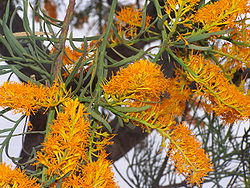- Nuytsia floribunda
-
 Nuytsia floribunda
Nuytsia floribunda
Nuytsia floribunda Classification classique Règne Plantae Sous-règne Tracheobionta Division Magnoliophyta Classe Magnoliopsida Sous-classe Rosidae Ordre Santalales Famille Loranthaceae Genre Nuytsia Nom binominal Nuytsia floribunda
(Labill.) R.Br., 1831Classification phylogénétique Ordre Santalales Famille Loranthaceae 
D'autres documents multimédia
sont disponibles sur CommonsNuytsia floribunda, appelé communément l'« arbre de Noël de l'Australie occidentale », est un arbre parasite rencontré dans cet état. Il est célèbre pour ses fleurs d'un jaune brillant qui s'épanouissent autour de Noël (en été en Australie). Il peut atteindre 10 mètres de haut et fait partie de la famille des Loranthaceae comme le gui.
C'est un hémiparasite. Il sait faire la photosynthèse mais emprunte l'eau et les sels minéraux à son hôte. Les racines de la plante se fixent sur les racines des plantes voisines et accaparent leurs nutriments ce qui peut ralentir la croissance de la plante parasitée sans en provoquer la mort. Les racines peuvent aussi s'enrouler autour de câbles souterrains, les confondant avec des racines.
Références
- Référence Florabase (Australie Ouest) : classification Nuytsia floribunda (+description) (en)
- Référence NCBI : Nuytsia floribunda (en)
- Référence GRIN : espèce Nuytsia floribunda (Labill.) R. Br. (en)
- Calladine, Ainsley and Pate, John S. 2000. Haustorial structure and functioning of the root hemiparastic tree Nuytsia floribunda (Labill.) R.Br. and water relationships with its hosts. Annals of Botany
- Association of Societies for Growing Australian Plants (ASGAP) Nuytsia floribunda
- Thomas Göbel: Heilpflanzen gegen Krebs und Psychose, Nuytsia Floribunda und Viscum Album, Betrachtung und Beurteilung zweier polarer Pflanzencharaktere und ihre Anwendungsmöglichkeiten. Verlag Freies Geistesleben, Stuttgart/Allemagne 2004, ISBN 3-7725-2230-0
Catégories :- Flore (nom scientifique)
- Loranthaceae
- Arbre d'Australie
- Arbre d'ornement
- Arbre de climat méditerranéen
- Plante parasite
Wikimedia Foundation. 2010.
